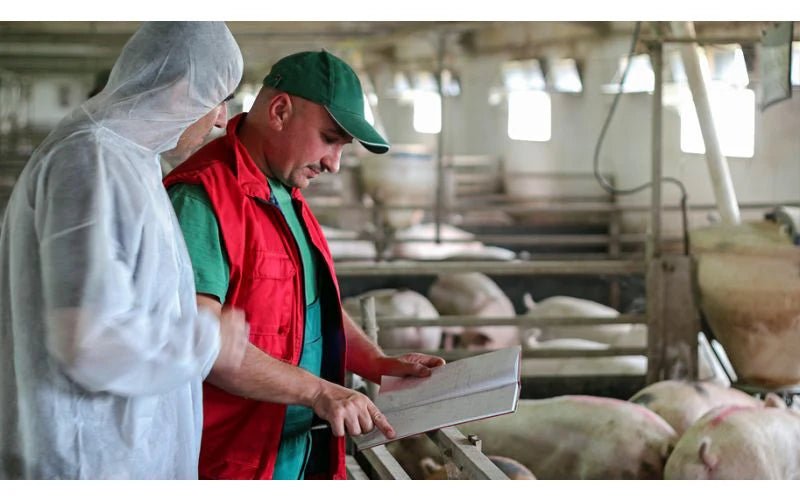
Guarding Against Infection: Hygiene Protocols for Pig Barn Workers
|
|
Time to read 3 min
 You are being redirected to QC Supply Pharmacy, where you’ll find a wide selection of high-quality prescription and pharmaceutical products for animals of all sizes.
Enjoy the same great service and expertise you trust from QC Supply.
Click below to continue shopping.
Continue
No thanks, stay on the main site
Powered by
You are being redirected to QC Supply Pharmacy, where you’ll find a wide selection of high-quality prescription and pharmaceutical products for animals of all sizes.
Enjoy the same great service and expertise you trust from QC Supply.
Click below to continue shopping.
Continue
No thanks, stay on the main site
Powered by


|
|
Time to read 3 min
The typical production facility employee is covered with more bacteria than there are people in the United States. Even with a shower-in, shower-out protocols (an essential aspect of pig barn hygiene), workers still share facilities and can make each other sick or spread infections. Facility employees should be following all biosecurity protocol instructions to a “T” as part of their hygiene best practices. This is crucial for infection prevention and overall livestock disease control.
Healthy and clean facility workers are much less likely to introduce infections. Even small details, like the soap they use, can make a difference in limiting exposure. Establishing a clean environment and expecting all employees to maintain strict adherence to personal hygiene biosecurity protocols can make a difference in preventing disease spread in pig barns.
“What is hygiene?” in livestock management is an integral question. Hygiene means keeping clean to stay healthy and avoid getting sick. It includes practices that help prevent diseases and maintain good health. The goal of handwashing and general cleaning is to break the transmission route of microorganisms from employee's hands to anywhere else.
In production facilities (particularly those focusing on swine facility biosecurity guidelines), a good biosecurity plan emphasizes the practice, or the act, of staying clean. This underscores the importance of personal hygiene in swine production.
All employees must commit to vigilantly and vigorously cleaning themselves multiple times a day. Similarly, producers and management should make expectations clear with ample, appropriate signage and reinforce the message with regular reminders.
Handwashing
Handwashing protocols are essential: Good hygiene begins with clean hands. All employees should wash their hands often with soap and warm water for at least 15 seconds at a time. This is particularly important before safe food preparation in animal facilities and after eating.
If soap and water are not easily available, effective hand sanitizer use (alcohol-based) can be an adequate substitute—but only if hands are not visibly dirty. Additionally, personal protective equipment (PPE) for farm workers should be used whenever necessary to further reduce cross-contamination and support employee health and safety measures.
A break room should be provided for safe food preparation in animal facilities and meals. Employees should not wash their hands in the same sink where they wash and clean eating utensils. Additionally, employees should not eat or bring food to areas where animals are housed to maintain production facility sanitation.
Cuts and Scrapes
Cuts and scrapes are common annoyances most people deal with regularly. For production facility workers, however, they represent a cuts and scrapes biosecurity risk. Thus, proper wound care for production workers is crucial.
Cuts and scrapes should be treated immediately and should remain covered with a clean dressing until the wound is completely healed. Producers should post the proper protocols and make sure all employees understand that the smallest abrasion must be treated seriously.
Additionally, local healthcare provider contact information should be made readily available if employees have questions. If an employee has a skin infection, they should consult a healthcare provider right away to prevent spreading it to others.
Personal Items
Employees should never share personal hygiene items for shower-in, shower-out protocols. This includes soap, washcloths, towels, flip-flops or shower shoes, and after-shower clothing.
Using a liquid soap dispenser in the shower lowers the risk of infection from sharing the same bar soap. This highlights the liquid soap dispenser benefits. After showering, all used clothing and towels should be washed in hot water with laundry detergent and bleach.
Clean Environment
Post cleaning procedures in office and living areas (consider using a daily facility cleaning checklist to ensure thoroughness). All employees must understand and follow the protocols. Floors, counters, eating utensils, desktops, and shared facility phones should be cleaned daily, and the trash should be emptied at least once per day.
Use an EPA-approved disinfectant or a mix of one-quarter cup bleach in a gallon of water as proper disinfectant solutions for cleaning and disinfecting procedures in showers. This solution should be newly mixed every morning to ensure it remains effective in maintaining a clean environment.
Facility employee hygiene is of utmost importance. All employees should understand the need to maintain good hygiene off-hours—this is especially important for off-hours hygiene for pig farm employees—and follow all protocols while on-site, observing that:
Employee health and safety measures must be prioritized as part of successful biosecurity, which is the responsibility of everyone. Want to learn more about biosecurity and disinfection? Check our articles below:
Did we miss any important biosecurity hygiene practices? What do you require employees to do in your facility? Tell us in the comments section!